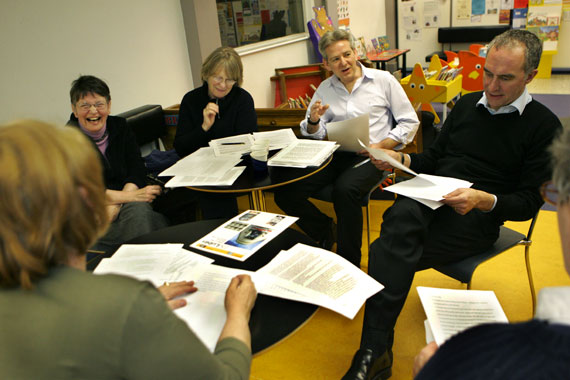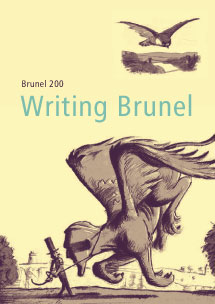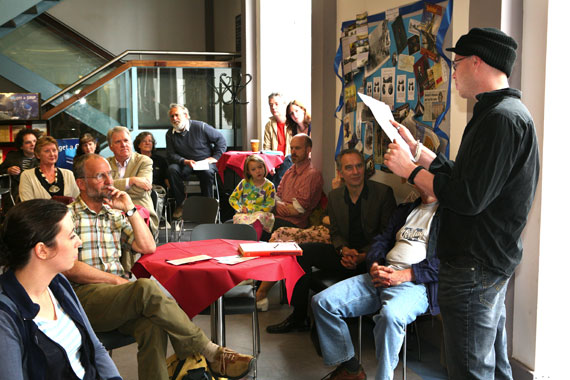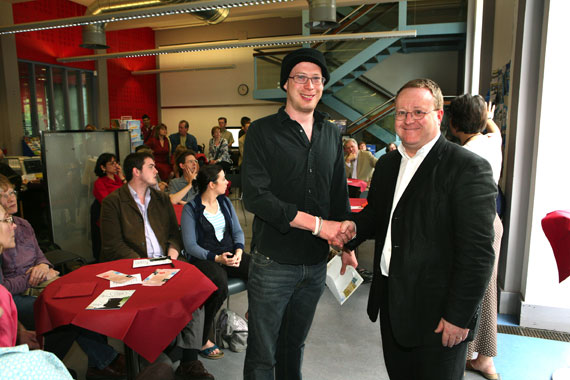|
|




Bristol libraries wanted to use the legacy
of Brunel to inspire creativity today and to encourage new creative people.
To encourage new writing in the city, they decided to run two projects to
celebrate Brunel’s
200th birthday.
Creative writing
The first was a short story competition on the theme of Brunel, supported
by creative writing workshops to help people develop their creative
writing skills. The workshops were led by local authors and were held
at a good selection of libraries across the city:
Bristol Central Library with Glenn Carmichael
Bedminster Library with Jeannie Johnson
Fishponds Library with Pip Granger
Westbury Library with Patricia Ferguson

All the workshops were well attended,
with a total of 45 aspiring writers turning up.
“I would like to thank the library for running the writers’ workshop
I have just attended. It was very inspiring to work and learn with the
author Jeannie Johnson. She was practical, informative and encouraging.
Her criticism was to the point and she was generous with her knowledge
of writing and publishing. I do hope the libraries will run more of these
workshops. I have been greatly encouraged by them and I now want to learn
more.”
Mary Dainton, workshop participant
In addition there were drop-in open mic
sessions at the Central Library in the café area, for writers to
try out their stories aloud. These turned out to be less popular, a surprise
in view of the popularity of the regular open mic sessions held for
poets in conjunction with Poetry Can. However, all the writing workshops
also included this element, so there were other opportunities for writers
to obtain this kind of feedback.
The main part of the project was the competition
for stories of up to one thousand words on the Brunel theme. Prizes were:
First: £150
plus the story read by a literary agent
Second: £100
Third: £50
17 runners-up prizes of a £5 book token
132 entries were received, including
one submitted in Gujarati. The entries were judged by a panel of
representatives from local reading groups, chaired by Tom Sperlinger,
Lifelong Learning Officer for Humanities, University of Bristol.
The winners were announced at a prize giving ceremony held on 6 May
at the Central Library, when the prizes were presented by Andrew
Kelly of Brunel 200.
To round off the project, the twenty shortlisted
stories were published in a booklet, with the winning three stories
illustrated by local artist Simon Gurr. Copies are held in all
libraries. |
|
 |
Graphic novel workshops
Three graphic novel workshops for young adults were held during the half
term holiday at the beginning of June, in Bristol Central Library,
Henbury Library and Bristol Prison. Simon Gurr, illustrator of the
Brunel graphic biography published by Brunel 200, led the workshops.
The aim behind the workshops was to involve young people
in a creative process and, through this, enable them to learn more about
Brunel and his work. Simon showed the young people some of the work he
had done and took them step-by-step through the process. They then each
produced a cartoon story, which was made into a page of a comic. Staff
at Henbury Library reported that the young people thoroughly enjoyed themselves,
and the library later staged a display of their work.

Feedback from Alison Duffy, Prison Librarian at Bristol Prison:
“The
prison library shared in the Brunel 200 celebrations on 15th June with
an all-day graphic art workshop run by Simon Gurr. It was supported by
the education department's art teacher and attended by 10 prisoners. Simon
talked about comics in general, about the history of comic strips and different
comic styles, and about working as a graphic artist. The participants each
thought up a story line, illustrated it and produced a comic strip. We
hope to make these into a simple booklet.
It was a new experience for everyone
and much enjoyed by all who took part – Simon included! They were also
each given a copy of the Isambard Kingdom Brunel graphic biography.
Thanks
to Cynthia and Chris for including the prison in this project.”

Simon
added:
“I took two workshops at the prison, on
the practical process of making comics. Both sessions were with the same group
of prisoners who were all members of the art class. For me the workshops were
an extremely valuable experience, an opportunity to visit a place most people
never see and to meet some very interesting people. I was made welcome and
greatly assisted by Alison Duffy, the Prison Librarian and Pauline Palmer,
the art teacher. Alison showed me the prison library, where the collection
of graphic novels is very popular with prisoners, but the workshops themselves
took place in another part of the education block.
The people who took
part in the workshop ranged in age from late teens to forties and were
from varied backgrounds. I used the same structure for their workshops
as I had done with the other library sessions, so the differences were
clear. There was a lot more humour in the prisoners’ work,
they cared more about the technical finish to their artwork and the stories
they wrote tended to be more autobiographical than those of the younger
participants in the other workshops (who often incorporated TV characters
into their narratives). Subjects included life in prison, life after
prison and football. In fact, the second workshop had to run to a very
tight schedule because England were playing in the World Cup that afternoon
and I promised not to overrun. As the kick-off drew nearer the prisoners
became slightly distracted but nevertheless they managed to produce a
fantastic set of comic strip pages by the end of the session.”
Library
feedback
| • |
Library staff involved in the
project are delighted by how it has gone. The success of the
creative writing workshops was particularly gratifying and we
see this as an area where there is clearly a lot of scope for
more work. We hope that the project will lead to sustained activity
in this area. At Bedminster Library there is now a permanent
writing group. |
| |
| • |
Having a series of workshops across the city
involved a large number of staff in the project and made them
feel part of the Brunel celebrations. |
| |
| • |
Writers borrowed books about Brunel and were
keen to learn more about him for their stories. |
| |
| • |
We have strengthened our links with local
authors and illustrators, and developed new links in the community,
such as Community at Heart. |
| |
| • |
Library staff were invited onto Radio Bristol
to talk about the project. |
| |
| • |
The open mic sessions were less popular than
anticipated so we reduced the number and diverted the cash to
an extra graphic novel workshop at the prison. |
| |
| • |
We received one entry for the competition
in Gujurati, which was translated. |
| |
| • |
The judges were impressed by the number, the
variety and the high standard of the short story entries – and
the winners were all local. There were some popular themes but
also some strikingly original approaches. |
| |
| • |
The graphic novel workshops were received
enthusiastically and again we see scope for further activity
with young people in this area. |
Winning entry: The Sphinxes who
wouldn’t sit still
by Benjamin Tucker
“Have you tried rivets?” shouted the
short man in the stovepipe hat.
“Rivets, chains, everything!” cried
the navvy, exasperated, mopping his brow.
“Nothing will hold them!”
“Why won’t they just sit still!” demanded
the man in the hat, whose name was Brunel.
“I don’t understand it”, said the Italian, shaking
his head and stroking his wiry black beard. “In Egypt, all they
ever do is sit still”.
“Well they’re not sitting still now!” exclaimed
Brunel, gesturing wildly to where a group of labourers were struggling
to stop two winged creatures from taking flight. Each creature had,
as well as a pair of red wings, the body of a lion and the head of
a man. Around the neck of each creature was a rope and on the end of
each rope a half dozen men fighting to keep their feet on the ground.
“What
did you say they were called again?” asked Brunel, who was an
engineer.
“Sphinxes” answered the Italian, whose
name was Caviglia. He had brought the twin creatures at no small
expense all the way from Egypt in Africa to Bristol in the west of
England. He had uncovered them while excavating the Great Pyramids
at Giza. Right now the pair stood, if not exactly still as statues,
on a grassy field atop a limestone gorge while around them groups
of workmen shouted and waved their hands. It was first light and
in the darkness a river the colour of oil and tar snaked far below.
“Well Mr Sphinx” growled Brunel, rolling up his sleeves, “Let's
see how tough you really are”.
Determinedly, the engineer strode
towards the nearest tug of war. Reaching the contest, he took hold
of the rope that tethered the creature and, with one swift jerk, brought
the face of the sphinx down level with his own. The creature stopped
struggling, narrowed its eyes and focused its attention on the figure
before it. Face to face, whiskers apart, man and sphinx studied each
other intently for some moments. Then, as if deciding he had the measure
of the other, the man in the tall hat spoke.
“My name is Isambard Kingdom Brunel” he declared, the
stub of a cigar clenched between his teeth. “My Great Western
Railway is the finest work in England and runs from London to Bristol
through a tunnel two miles long cut from solid rock. I have engineered
the largest and most powerful steamships ever built, carrying passengers
and cargoes from the Old World to the New. My train tracks bear locomotives
from Ireland to Bengal and beyond. This bridge (continued the engineer,
indicating to an unfinished tower behind him) that I have fought long
and hard to build will, when complete, span the Avon gorge and you,
my obstinate friend, and your companion will sit atop its towers and
watch over those who cross it”. And with a ‘humph’ of
cigar smoke Brunel fixed the sphinx with a stone hard stare as if to
say “I dare you to answer me back”.
Impassively, the Sphinx
considered the man for a moment. The creature was completely still but
for the slow, gentle beating of its huge red wings. The draught from
its mighty feathers fanned the end of the engineer’s
cigar so that the glow from its embers caught the features of the man’s
face. Then with an enigmatic smile and a voice as dry and ancient as
sand the Sphinx replied:
“I know who you are Isambard Kingdom Brunel
and I know of your achievements. I understand better than you how
your feats of engineering will affect the lives of every man and woman
on this planet. For better or worse you have made this world a smaller
place, young man”. And with this the sphinx exhaled
and Brunel caught the scent of the Orient and felt the heat of the
desert sun against his face. He felt giddy of a sudden, not a sensation
he was familiar with, and then darkness and water cold all around him
and the sound of men screaming. “You are a great man Brunel” cried
the Sphinx in a voice like the sound of a tomb being sealed, “the
finest engineer of this era. But my twin and I are millennia old and
we have met many great men, known many engineers”.
And with that
the Sphinx shook itself and the rope slipped from out of Brunel’s
hands. The noble creature took one step back and with a gracefulness
its size belied bowed ever so slightly before the man. Brunel, shaken,
returned the honour. Then with a single bound the Sphinx was airborne
and away, rising high over the gorge and the river and the city below.
Seeing
this the labourers struggling with the second Sphinx shrugged their
shoulders and let their captive go. With one mighty sweep of its wings
the second creature took flight, soaring to catch its companion who
was already disappearing into the eastern sky and the rising sun.
Heading
back to where Caviglia stood, Brunel lifted his hat and scratched the
top of his head.
“I think”, said the engineer wearily, “that we could
all do with a break”.
Brunel did not live to see his bridge completed.
Construction stopped in 1845 and did not start again until after
his death in 1859 when the Institution of Civil Engineers decided
that the completion of the bridge would be a fitting memorial to
the great engineer. The finished bridge still spans the Avon gorge
to this day but without its pair of Sphinxes which were omitted from
the final, revised design due to ‘lack
of funds’. If you are lucky enough to visit the Museum of Egyptian
Antiquities in Cairo you will see lots of Sphinxes all sat entirely
still. None of them have wings, which might explain why they’re
still sat there.
Photography: Mark Simmons.
|
|


